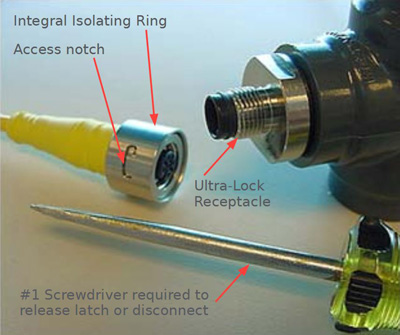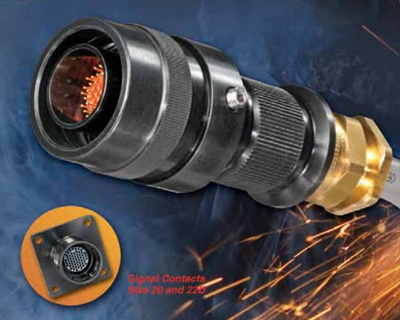Specifying explosion-proof connectors
The threat of explosion is real in many industrial applications, from petrochemical refineries and cleaning facilities to flour silos and even landfill sites. While explosion is a hazard anywhere there is a flammable substance in the atmosphere in the form of gas, vapour or dust, the presence of the flammable substance on its own is not enough to trigger an explosion.
The three basic requirements for an explosion also include an oxidiser, most commonly oxygen in the air, and a source of ignition.
The best way to prevent electrical equipment from causing an explosion is not to use it in areas where these flammable substances are present, but of course, that can’t always be avoided. Explosion proofing of electrical equipment is therefore necessary, which focuses on limiting the equipment’s access to air, restricting potential sources of ignition such as arcs, sparks and any hot surfaces, and/or containing explosions within an appropriate enclosure.
Since the various methods of protecting equipment from explosion are effective to different extents, classifying the nature of the particular hazardous environment being considered is necessary to allow appropriate levels of explosion proofing to be employed.
The standard used in North America defines hazardous areas as Class I (presence of flammable vapours or gases), Class II (presence of flammable dust) or Class III (presence of easily ignitable fibres or flyings). These classes are subdivided into divisions which express how likely the flammable material is to be present in concentrations that can cause an explosion. Division 1 means these concentrations are normally present, or these concentrations are frequently present due to equipment failure or maintenance work. Division 2 means ignitable concentrations are normally in closed containers or closed systems that are only breached in the event of an accident. There are further subdivisions based on Groups (labelled A-G), which define the flammable substances themselves, and temperature ratings from T1 to T6, where T1 is least stringent (hottest allowable temperature is 450°C) and T6 is the most stringent (equipment surfaces can only reach 85°C).
For example, an area classified as Class II, Division 1, Group G, T3 is exposed to non-conductive dust such as flour or sawdust under normal operation, and the maximum allowable temperature that equipment can reach is 200°C.
An alternative system used for classifying hazardous areas is the zone system, widely used in Europe. The zone system uses three levels of hazard probability (as opposed to two Divisions in the other system). The presence of a continuous explosive atmosphere is Zone 0, intermittent or periodical explosive atmosphere is Zone 1 and if the explosive atmosphere occurs only in abnormal conditions, then it’s Zone 2. Zones are subdivided into Groups that indicate the exact flammable substance present - this is similar to groups in the other system, though the naming is of course different. For example, Group II is the flammable gases; IIC is the most severe as it includes Acetylene an d Hydrogen, IIB is Ethylene and IIA is Propane.
An alternative system used for classifying hazardous areas is the zone system, widely used in Europe. The zone system uses three levels of hazard probability (as opposed to two divisions in the other system). The presence of a continuous explosive atmosphere is Zone 0, intermittent or periodical explosive atmosphere is Zone 1 and if the explosive atmosphere occurs only in abnormal conditions, then it’s Zone 2. Zones are subdivided into Groups that indicate the exact flammable substance present - this is similar to Groups in the other system, though the naming is of course different. For example, Group II is the flammable gases; IIC is the most severe as it includes Acetylene an d Hydrogen, IIB is Ethylene and IIA is Propane.
Confusingly, zones have now been introduced in North America for Class I (flammable vapour or gas) locations too, though zones and Divisions are not directly comparable. Division 1 is effectively split into Zone 0 and Zone 1, with Division 2 being the equivalent of Zone 2. For Class II (dust), the equivalent zones are sometimes called 20, 21 and 22, though these are not standard in North America yet.
Connectors are critical to explosion proofing since they have the potential to create arcs and sparks as part of normal operation. Manufacturers of explosion-proof connectors have many ways of reducing the potential for arcs, or containing any arcs that do occur in specially designed receptacles. Connectors are specified as safe for a particular class of hazardous environment as per the standards mentioned above.
For example, Molex’s Brad Ultra-Lock EX (pictured, below) connection system is designed for Class I, Division 2 and Zone 2 hazardous locations. This system of M12 circular connectors features a built-in locking mechanism, so while the connector is simply pushed to mate, a screw driver is required to unmate it. Since the connection points are non-arcing, the connectors are safe to use in areas where flammable gases or vapours may occur during abnormal conditions in food and beverage processing, oil refineries and pharmaceutical manufacturing.

Amphenol offers the Starline-EX and Amphe-EX ranges of explosion-proof industrial connectors (pictured, below) for applications like natural gas processing equipment, mining and offshore platforms. Both these series are manufactured with tighter tolerances in mating junctions to limit the exposure of the contacts to any explosive atmosphere present. Both Starline-EX and Amphe-EX are safe for Zone1-IIC applications, with T5 and T6 ratings are available.

Starline-EX connectors offer a variety of backshell arrangements and contact inserts for power (up to 1135A at 1000V), signal (up to 143 contacts) and mixed power control applications. Amphe-EX are smaller wire gauge (12-28AWG) power and signal connectors for copper, fibre optics, coax or mixed conductors, and they come in RJ45 and USB versions.







